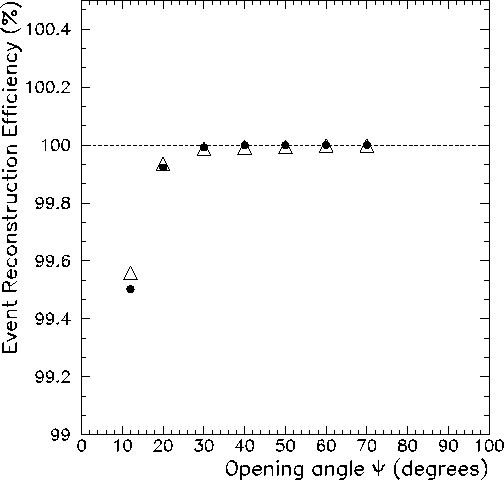The event reconstruction efficiency has been studied by implementing an algorithm which does the following:
The optimal cluster size for best event reconstruction efficiency
can be inferred from a graph of efficiency plotted against ![]() , for
simulated 70 MeV photons and positrons. Again, it is clear that the
efficiency for
, for
simulated 70 MeV photons and positrons. Again, it is clear that the
efficiency for ![]() approaches the ideal value which occurrs
at
approaches the ideal value which occurrs
at ![]() .
.

Figure 6.5: Event reconstruction efficiency as a function of the
cone opening angle ![]() , for simulated 70 MeV photons and
positrons. The dotted horizontal lines represent the asymptotic values for
360
, for simulated 70 MeV photons and
positrons. The dotted horizontal lines represent the asymptotic values for
360![]() summing.
summing.
From the plots in Figs. 6.3 through 6.5, one can
deduce that the energy resolution and event reconstruction efficiency
approach ideal values for a cone opening angle of ![]() . By
inspection of the graphs in Fig. 6.2, one can see that
this corresponds to a cluster size of about 17 crystals, or one
central crystal surrounded by two concentric rings of crystals. This
arrangement can be seen in the two dimensional projection of the whole
240-element PIBETA calorimeter, shown in Fig. 6.6.
. By
inspection of the graphs in Fig. 6.2, one can see that
this corresponds to a cluster size of about 17 crystals, or one
central crystal surrounded by two concentric rings of crystals. This
arrangement can be seen in the two dimensional projection of the whole
240-element PIBETA calorimeter, shown in Fig. 6.6.
Figure 6.6: Two dimensional view of PIBETA calorimeter. One can see that
the optimal cluster size of ![]() 17 crystals corresponds to one central
crystal surrounded by two rings of neighboring crystals.
17 crystals corresponds to one central
crystal surrounded by two rings of neighboring crystals.